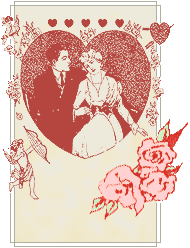
 |
| Sensuous Bath Oil |
Contentment in this life basically boils down to the need to love and be loved. To feel productive, have a role in something that matters. Should we just disappear, that someone would notice. Even those who like being alone need social stimulation once in a while.
Doing for others for the sake of helping isn't purely altruistic, since if we really examined ourselves we do what we do not only for that other person but because those actions make us feel better about ourselves. The desire to please and help others are wonderful qualities, but if you go into it with expectations of the other person's reaction, you cannot be overly sensitive. Trying to understand why people don't behave the way we think they would, or should. will drive you crazy.
Perhaps that is why Valentine's Day can range from being a day of fulfilled expectations to heart shattering disappointment. As long and men and women are wired so differently, men will always feel they did something wrong and women will always have their hearts in an unrealistic reality. If men could just remember that most of the supposedly irrational behavior of women all stems from the plea to "notice me"! Feeling appreciated and noticed goes a long way in the love bank point system. It's the little everyday things that matter, not the seesaw of going overboard just because it's a Hallmark holiday and then slipping right back into indifference.
As long as we remember that love is a verb; an ongoing stretch of efforts, highs, lows, tears, joys and rewards. What it is not is fleeting feelings wrapped up in emotion or temporary passion. Keep those moments in perspective and you'll be on your way to wisdomville. In order for romance to remain alive and full of hot energy we must periodically add some fuel and stir up the simmering ashes. Remember the actual meaning of the word "passion" is an intense, burning desire for something. Those embers don't spark all by themselves. Throw some of yourself into the relationship once in a while and see how hot your fires can get!
A bit of information on St. Valentine history:
Valentine's Day History
Pagan festivals, Christian saints, Chaucer's love birds, and the Greeting Card Association of America
by Borgna Brunner
 |
Roman Roots
The history of Valentine's Day is obscure, and further clouded by various fanciful legends. The holiday's roots are in the ancient Roman festival of Lupercalia, a fertility celebration commemorated annually on February 15. Pope Gelasius I recast this pagan festival as a Christian feast day circa 496, declaring February 14 to be St. Valentine's Day.Valentines Galore
Which St. Valentine this early pope intended to honor remains a mystery: according to the Catholic Encyclopedia, there were at least three early Christian saints by that name. One was a priest in Rome, another a bishop in Terni, and of a third St. Valentine almost nothing is known except that he met his end in Africa. Rather astonishingly, all three Valentines were said to have been martyred on Feb. 14.Most scholars believe that the St. Valentine of the holiday was a priest who attracted the disfavor of Roman emperor Claudius II around 270. At this stage, the factual ends and the mythic begins. According to one legend, Claudius II had prohibited marriage for young men, claiming that bachelors made better soldiers. Valentine continued to secretly perform marriage ceremonies but was eventually apprehended by the Romans and put to death. Another legend has it that Valentine, imprisoned by Claudius, fell in love with the daughter of his jailer. Before he was executed, he allegedly sent her a letter signed "from your Valentine." Probably the most plausible story surrounding St. Valentine is one not focused on Eros (passionate love) but on agape (Christian love): he was martyred for refusing to renounce his religion.
In 1969, the Catholic Church revised its liturgical calendar, removing the feast days of saints whose historical origins were questionable. St. Valentine was one of the casualties.
Chaucer's Love Birds
It was not until the 14th century that this Christian feast day became definitively associated with love. According to UCLA medieval scholar Henry Ansgar Kelly, author of Chaucer and the Cult of Saint Valentine, it was Chaucer who first linked St. Valentine's Day with romance.In 1381, Chaucer composed a poem in honor of the engagement between England's Richard II and Anne of Bohemia. As was the poetic tradition, Chaucer associated the occasion with a feast day. In "The Parliament of Fowls," the royal engagement, the mating season of birds, and St. Valentine's Day are linked:
For this was on St. Valentine's Day,
When every fowl cometh there to choose his mate.
Tradition of Valentine's Cards


No comments:
Post a Comment